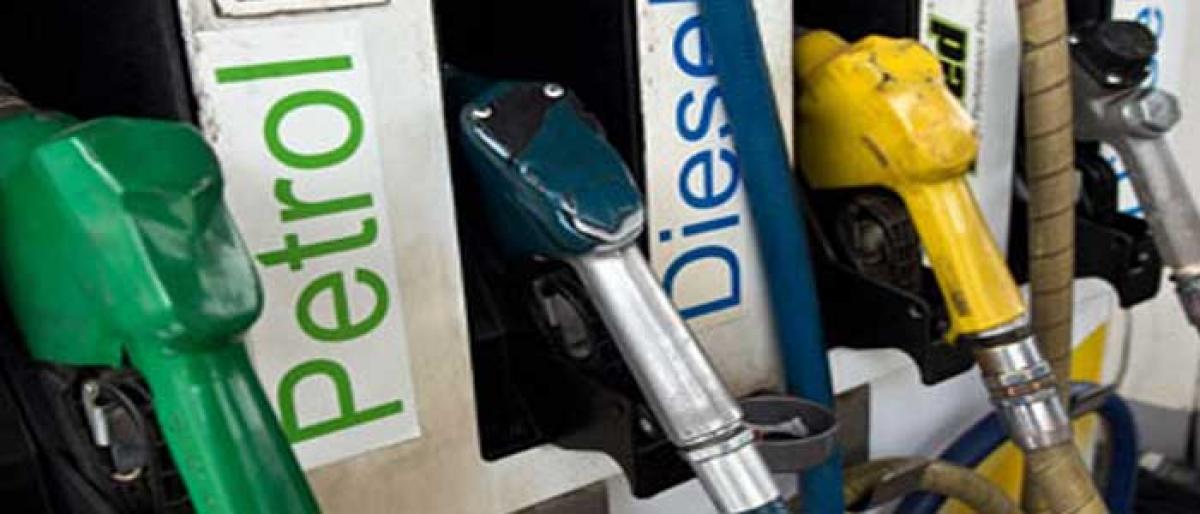Live
- World Bank okays loan for new project to boost earnings of UP farmers
- Zomato gets GST tax demand notice of Rs 803 crore
- Atul Subhash suicide: No arrests made yet, says Bengaluru Police Commissioner
- Indian agrochemicals sector to see 7-9 pc growth next fiscal: Report
- SC refers to CJI Cong leader’s petition for verification of EVMs used in Haryana polls
- To become the youngest world champion is truly a great feat: Gill congratulates Gukesh
- Case Filed Against Allu Arjun Under Four Sections
- Remembering A Visionary Leader.
- CREDAI Bengaluru seeks govt support for E-Khata issues
- Driverless Namma Metro nets revenue of `230 crore even before its launch
Just In

Not long ago, petrol and diesel used to be a huge drag on the central government’s coffers owing to huge subsidies that it had to extend to keep their prices lower. But the trend was reversed with the Modi government, which assumed power in 2014, refusing to pass the benefits of lower crude oil prices to the end consumers
Not long ago, petrol and diesel used to be a huge drag on the central government’s coffers owing to huge subsidies that it had to extend to keep their prices lower. But the trend was reversed with the Modi government, which assumed power in 2014, refusing to pass the benefits of lower crude oil prices to the end consumers.
For instance, petrol price was around Rs 68 a litre in 2012 when crude oil price hovered over $120 per barrel. But global oil prices fell drastically in the last three years, quoting far less than half of what it was then. The Indian crude basket, comprising 73 per cent sour-grade Dubai and Oman crudes, was available at $51.34 on Monday this week. The low price means petrol and diesel prices in India should come down by more than half of what they were in 2012. However, on the same Monday, petrol in Mumbai cost a whopping Rs 79.41 a litre, hitting a three-year high.
But why the petrol and diesel prices are still at historic highs despite crude oil prices being at historic lows? The answer to this question lies in the multiple taxes and multiplying rates that these products attract now.
In the last three years, the central excise duty on petrol doubled to Rs 21.48 per litre while on diesel, it went up by four times to Rs 17.33 a litre. As consequence, the central government could triple its tax kitty from petrol and diesel to a staggering Rs 2.42 lakh crore in FY17 from Rs 77, 982 crore in FY14.
This indicates that benefits from the lower crude oil prices have flown into the central government’s coffers while consumers continue to pay ‘heavy price’ for fossil fuels.
It may sound intriguing, but the country has not witnessed much of a public outcry either against increase in the taxes or rise in the prices. This is partly due to the price-revision mechanism the government adopted post deregulation of pricing seven years ago. Till recently, oil marketing companies changed prices every fortnight in tune with global crude oil rates. As a result, consumers could not keep track of the prices. For the middle of June this year, the government went for daily pricing mechanism which further helped it escape from any backlash.
But with prices reaching three-year high now, it’s unlikely that the government will escape from criticism as such high prices will invariably start pinching the consumers. Moreover, the government’s policy of passing the burden on to people whenever crude prices go up while filling its coffers when the prices go down, will show it in poor light.
It’s high time the Modi government passed the benefits from low crude oil prices to people. This apart, petrol products should be brought under GST to bring down tax burden on fuels. Even at the highest GST rate of 28 per cent, taxes will be far lower than the existing rates. Besides, it will eliminate tax anomalies as prices greatly vary from state to state now. Time for the Modi government to act before it’s too late!

© 2024 Hyderabad Media House Limited/The Hans India. All rights reserved. Powered by hocalwire.com







